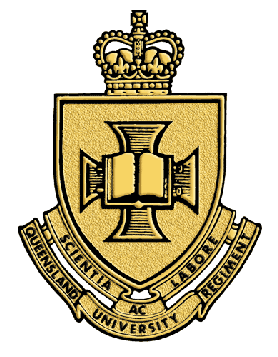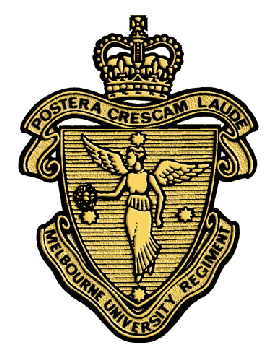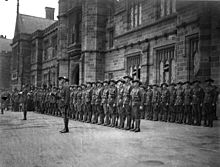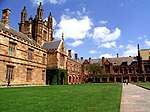
Queensland University Regiment (QUR) is a training unit of the Australian Army Reserve. Based in Queensland, the regiment is currently assigned to the 8th Brigade. The regiment's history can be traced back to 1932 when the University Rifles was formed. During World War II, the regiment's predecessor unit did not serve overseas, but many of its personnel were deployed as part of the 7th Brigade or within units of the Second Australian Imperial Force. After the war, the regiment was formed under its current designation. Since then, its size has fluctuated as its role has changed. Currently, it is responsible for providing training for Reserve officer cadets, officers and soldiers.

Lieutenant General Sir Carl Herman Jess, was an Australian Army officer who served in the First and Second World Wars.

The Melbourne University Regiment (MUR) is an officer training unit in the Australian Army Reserve (ARes). It has a depot at Grattan Street, Carlton, Melbourne, Australia.

The 1st/19th Battalion, The Royal New South Wales Regiment is an infantry battalion of the Australian Army. It is one of four battalions of the Royal New South Wales Regiment and is currently a Reserve unit attached to the 5th Brigade, 2nd Division. In its present form 1/19 RNSWR was raised in 1971 with the amalgamation of the 1st Battalion and the 19th Battalion. These two units were previously linked between 1930 and 1939, although they can trace their lineage back to 1854 with the formation of a number of Volunteer Rifles units as part of the New South Wales colonial defence force. The battalion's headquarters is located in Romani Barracks, Orange, with four rifle companies spread across Wagga Wagga, Bathurst, Dubbo, and Canberra.
Adelaide Universities Regiment (AUR) is an officer training unit of the Australian Army headquartered in Adelaide, South Australia. Currently AUR maintains a cadre staff of trained Regular and Reserve personnel who oversee and administer the training of Reserve officer cadets. The majority of the regiment is currently based at Hampstead Barracks.

The University of New South Wales Regiment (UNSWR) is, as of 2018, an Army Reserve Recruit training unit under the command of the 8th Brigade.
Major General Paul Le Gay Brereton, is a Judge of the New South Wales Court of Appeal and a senior officer in the Australian Army Reserve. He commanded the 5th Brigade from 2008 to 2010 and Head of the Cadet, Reserve and Employer Support Division from 2010 to 2014. He led an Inspector-General of the Australian Defence Force investigation into criminal misconduct on the battlefield by Australian Special forces in Afghanistan, issuing the Inspector-General of the Australian Defence Force Afghanistan Inquiry Report in November 2020. In March 2023, he was appointed as the inaugural commissioner of the National Anti-Corruption Commission.
The New Year Honours 1964 were appointments in many of the Commonwealth realms of Queen Elizabeth II to various orders and honours to reward and highlight good works by citizens of those countries. They were announced on 1 January 1964 to celebrate the year passed and mark the beginning of 1964.
The Queen's Birthday Honours 1963 were appointments in many of the Commonwealth realms of Queen Elizabeth II to various orders and honours to reward and highlight good works by citizens of those countries. The appointments were made "on the occasion of the Celebration of Her Majesty's Birthday", and were published in supplements to the London Gazette of 31 May 1963.
The King's Birthday Honours 1939 were appointments in many of the Commonwealth realms of King George VI to various orders and honours to reward and highlight good works by citizens of those countries. The appointments were made to celebrate the official birthday of the King. They were announced on 6 June 1939 for the United Kingdom and Colonies.
The New Year Honours 1923 were appointments by King George V to various orders and honours to reward and highlight good works by members of the British Empire. They were published on 29 December 1922.
The 1944 New Year Honours were appointments by many of the Commonwealth realms of King George VI to various orders and honours to reward and highlight good works by citizens of those countries. They were announced on 31 December 1943.
The King's Birthday Honours 1932 were appointments by King George V to various orders and honours to reward and highlight good works by members of the British Empire. The appointments were made to celebrate the official birthday of The King. They were published on 3 June 1932.
The King's Birthday Honours 1929 were appointments by King George V to various orders and honours to reward and highlight good works by members of the British Empire. The appointments were made to celebrate the official birthday of The King. They were published on 3 June 1929.
The 1926 Birthday Honours were appointments by King George V to various orders and honours to reward and highlight good works by citizens of the British Empire. The appointments were made to celebrate the official birthday of The King on 3 June, but it was announced on 20 May that due to the national strike, the King had approved the Prime Minister's recommendation to delay the publication of the list until 3 July 1926. The honours were effective to 5 June 1926. Per standard practice, Sir Paul Chater, who died 27 May 1926, still received the honour of Knight Commander of the Order of the British Empire as he would have received the honour if he had survived.
The 1917 Birthday Honours were appointments by King George V to various orders and honours to reward and highlight good works by citizens of the British Empire. The appointments were made to celebrate the official birthday of The King, and were published on 4 June and 19 June.
The 1919 Birthday Honours were appointments by King George V to various orders and honours to reward and highlight good works by citizens of the British Empire. The appointments were made to celebrate the official birthday of The King, and were published in The London Gazette from 3 June to 12 August. The vast majority of the awards were related to the recently ended War, and were divided by military campaigns. A supplementary list of honours, retroactive to the King's birthday, was released in December 1919.
The 1924 Birthday Honours were appointments by King George V to various orders and honours to reward and highlight good works by citizens of the British Empire. The appointments were made to celebrate the official birthday of The King, and were published in The London Gazette on 3 June 1924.
The 1927 Birthday Honours were appointments by King George V to various orders and honours to reward and highlight good works by citizens of the British Empire. The appointments were made to celebrate the official birthday of The King, and were published in The London Gazette on 3 June 1927.








